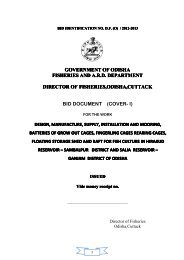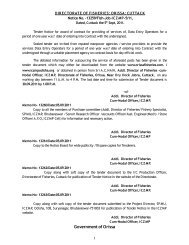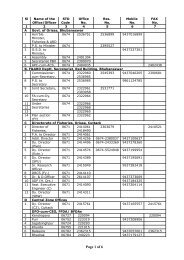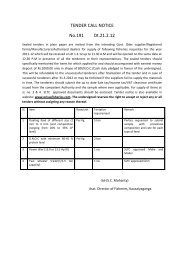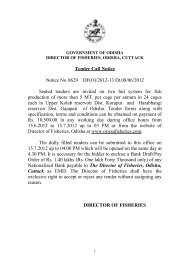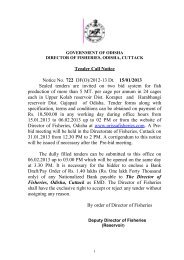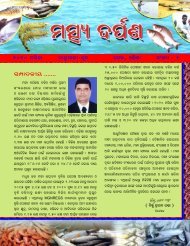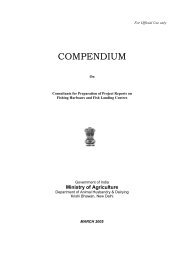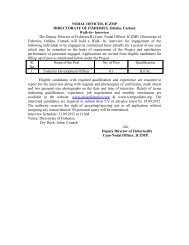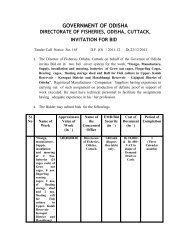Value Chain Analysis of Fishery in Puri and Ganjam District of Orissa
Value Chain Analysis of Fishery in Puri and Ganjam District of Orissa
Value Chain Analysis of Fishery in Puri and Ganjam District of Orissa
You also want an ePaper? Increase the reach of your titles
YUMPU automatically turns print PDFs into web optimized ePapers that Google loves.
Draft Report on “<strong>Fishery</strong> Supply <strong>Cha<strong>in</strong></strong>”<br />
Confidential<br />
2. To generate ga<strong>in</strong>ful rural employment with special reference to fish<strong>in</strong>g communities <strong>and</strong><br />
economic rehabilitation <strong>of</strong> displaced persons.<br />
3. To <strong>in</strong>troduce systematic management strategies both for conservation <strong>and</strong> susta<strong>in</strong>ed fish<br />
production<br />
4. To attract <strong>in</strong>creas<strong>in</strong>g <strong>in</strong>vestments from private sector.<br />
5. To stimulate entrepreneurship for fishery sector with special reference to reservoir fishery.<br />
6. To substitute traditional methods by <strong>in</strong>troduction <strong>of</strong> advanced technology <strong>in</strong> operation <strong>of</strong><br />
reservoir fishery.<br />
7. To develop skill among fishermen / fisherwomen <strong>in</strong> reservoir operation <strong>and</strong> organizational<br />
strengthen<strong>in</strong>g.<br />
8. To generate substantial revenue for the state<br />
The policy states that the ownership <strong>of</strong> the water resources will be shared between the village<br />
panchayat <strong>and</strong> the department Fisheries & ARD depend<strong>in</strong>g on the size <strong>of</strong> the resource. The policy<br />
gives a cutt<strong>in</strong>g edge to agriculture over fishery <strong>and</strong> def<strong>in</strong>es that <strong>in</strong>terests <strong>of</strong> agriculture will be<br />
given priority <strong>in</strong> case <strong>of</strong> conflict between the two.<br />
The policy provides leas<strong>in</strong>g right to the Primary Fishermen Cooperative Society/Societies formed<br />
under the <strong>Orissa</strong> Cooperative Societies Act, 19b2 or Society/Societies registered under the <strong>Orissa</strong><br />
Self- Help Cooperative Societies Act, 2001 (P.F.C.S.). This makes it imperative for the entire<br />
primary groups whether formal or <strong>in</strong>formal, to acquire registration from the specified state bodies<br />
to get lease over the water resource. Also the policy states that the lease will be granted through<br />
open auction <strong>in</strong> case no society comes forward for leas<strong>in</strong>g any water resource. This implies that<br />
the grant <strong>of</strong> lease will clearly witness the dom<strong>in</strong>ance <strong>of</strong> power <strong>and</strong> money with the deserv<strong>in</strong>g but<br />
less <strong>in</strong>fluential <strong>in</strong>dividuals be<strong>in</strong>g reduced to mere spectators <strong>in</strong> the bid to control <strong>and</strong> utilize the<br />
water resources <strong>of</strong> the state.<br />
The policy clearly spells out the conservation framework to improve upon the conservation status<br />
<strong>of</strong> the fresh water aquatic bio-diversity, which <strong>in</strong>cludes size <strong>of</strong> the carp, size <strong>of</strong> gill net, disposal <strong>of</strong><br />
<strong>in</strong>dustrial effluent, etc. But the policy seems to be <strong>in</strong>effective <strong>in</strong> terms <strong>of</strong> implementation <strong>and</strong><br />
enforcement measures def<strong>in</strong>ed <strong>in</strong> its own clauses <strong>and</strong> articles.<br />
3.2.2 <strong>Orissa</strong> Mar<strong>in</strong>e <strong>Fishery</strong> Regulation Act<br />
The <strong>Orissa</strong> Mar<strong>in</strong>e Fish<strong>in</strong>g Regulation Act came <strong>in</strong>to force <strong>in</strong> 1984 (DOF, 1997). The act def<strong>in</strong>es<br />
the natural coastal resource as the state property with all the management <strong>and</strong> usages right<br />
def<strong>in</strong>ed by the state. It negates the common ownership <strong>of</strong> the resource by the community <strong>and</strong> the<br />
management rights there<strong>of</strong>.<br />
The act was formulated ma<strong>in</strong>ly to protect the <strong>in</strong>terests <strong>of</strong> the traditional fishermen, by restrict<strong>in</strong>g<br />
the fish<strong>in</strong>g operations <strong>of</strong> the mechanised trawlers to with<strong>in</strong> 5 km from the shore <strong>and</strong> also prohibits<br />
fish<strong>in</strong>g activities <strong>of</strong> the trawlers from neighbour<strong>in</strong>g states enter<strong>in</strong>g <strong>in</strong>to the mar<strong>in</strong>e zone <strong>of</strong> the<br />
state.<br />
The act makes m<strong>and</strong>atory the registration <strong>of</strong> all the craft operat<strong>in</strong>g <strong>in</strong> the state aga<strong>in</strong>st the<br />
prescribed registration <strong>and</strong> license fee for different types <strong>of</strong> vessels. The act gives discretionary<br />
power to the government to regulate the fish<strong>in</strong>g operation along the coastl<strong>in</strong>e <strong>of</strong> the state. The<br />
state holds the power to regulate the number <strong>and</strong> type <strong>of</strong> vessel, area for fish<strong>in</strong>g, period <strong>of</strong> fish<strong>in</strong>g,<br />
species <strong>of</strong> fishes <strong>and</strong> the types <strong>of</strong> fish<strong>in</strong>g gear permissible for fish<strong>in</strong>g.<br />
The act clearly def<strong>in</strong>es the role <strong>and</strong> responsibility <strong>of</strong> the government <strong>of</strong>ficials <strong>and</strong> also empowers<br />
them to taken action aga<strong>in</strong>st the violators <strong>of</strong> the act. The penalties levied upon the <strong>of</strong>fender have<br />
been def<strong>in</strong>ed but at the same time the act has space for appeal aga<strong>in</strong>st the charges levied by the<br />
<strong>of</strong>ficials <strong>in</strong> the <strong>of</strong>fice <strong>of</strong> the appropriate appeal<strong>in</strong>g authority. The act has a special mention <strong>of</strong><br />
<strong>of</strong>fences by the companies <strong>and</strong> other corporate bodies to check the exploitation <strong>of</strong> the resources<br />
by them.<br />
The act is void <strong>of</strong> a concrete enforcement plan. For <strong>in</strong>stance, it does not def<strong>in</strong>e the human<br />
resources required to effectively monitor <strong>and</strong> control the fish<strong>in</strong>g activity, the sources <strong>of</strong> fund that<br />
Submitted by -: NiMble System Pvt. Ltd.<br />
Submitted to -: OXFAM (India) Trust 21



